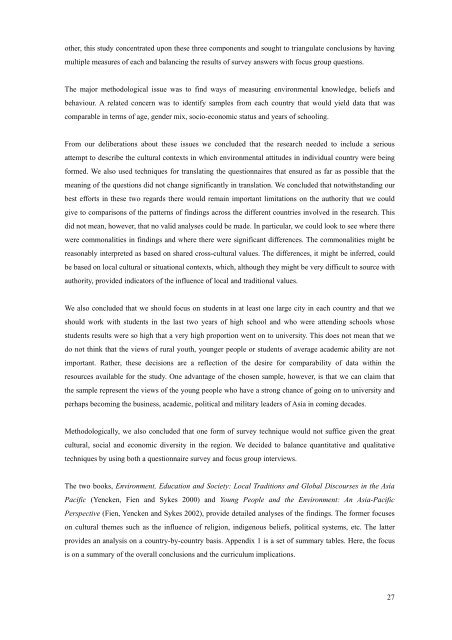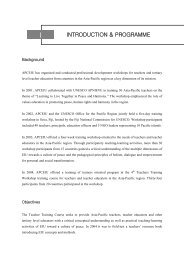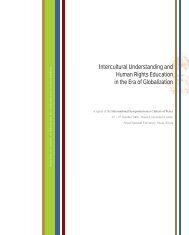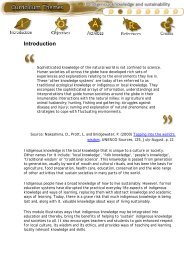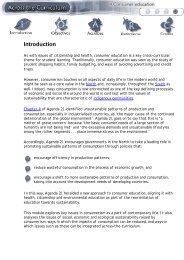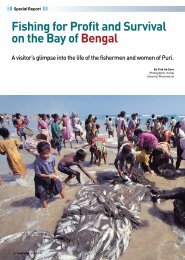REPORT OF UNESCO EXPERT MEETING ON - APCEIU
REPORT OF UNESCO EXPERT MEETING ON - APCEIU
REPORT OF UNESCO EXPERT MEETING ON - APCEIU
You also want an ePaper? Increase the reach of your titles
YUMPU automatically turns print PDFs into web optimized ePapers that Google loves.
other, this study concentrated upon these three components and sought to triangulate conclusions by having<br />
multiple measures of each and balancing the results of survey answers with focus group questions.<br />
The major methodological issue was to find ways of measuring environmental knowledge, beliefs and<br />
behaviour. A related concern was to identify samples from each country that would yield data that was<br />
comparable in terms of age, gender mix, socio-economic status and years of schooling.<br />
From our deliberations about these issues we concluded that the research needed to include a serious<br />
attempt to describe the cultural contexts in which environmental attitudes in individual country were being<br />
formed. We also used techniques for translating the questionnaires that ensured as far as possible that the<br />
meaning of the questions did not change significantly in translation. We concluded that notwithstanding our<br />
best efforts in these two regards there would remain important limitations on the authority that we could<br />
give to comparisons of the patterns of findings across the different countries involved in the research. This<br />
did not mean, however, that no valid analyses could be made. In particular, we could look to see where there<br />
were commonalities in findings and where there were significant differences. The commonalities might be<br />
reasonably interpreted as based on shared cross-cultural values. The differences, it might be inferred, could<br />
be based on local cultural or situational contexts, which, although they might be very difficult to source with<br />
authority, provided indicators of the influence of local and traditional values.<br />
We also concluded that we should focus on students in at least one large city in each country and that we<br />
should work with students in the last two years of high school and who were attending schools whose<br />
students results were so high that a very high proportion went on to university. This does not mean that we<br />
do not think that the views of rural youth, younger people or students of average academic ability are not<br />
important. Rather, these decisions are a reflection of the desire for comparability of data within the<br />
resources available for the study. One advantage of the chosen sample, however, is that we can claim that<br />
the sample represent the views of the young people who have a strong chance of going on to university and<br />
perhaps becoming the business, academic, political and military leaders of Asia in coming decades.<br />
Methodologically, we also concluded that one form of survey technique would not suffice given the great<br />
cultural, social and economic diversity in the region. We decided to balance quantitative and qualitative<br />
techniques by using both a questionnaire survey and focus group interviews.<br />
The two books, Environment, Education and Society: Local Traditions and Global Discourses in the Asia<br />
Pacific (Yencken, Fien and Sykes 2000) and Young People and the Environment: An Asia-Pacific<br />
Perspective (Fien, Yencken and Sykes 2002), provide detailed analyses of the findings. The former focuses<br />
on cultural themes such as the influence of religion, indigenous beliefs, political systems, etc. The latter<br />
provides an analysis on a country-by-country basis. Appendix 1 is a set of summary tables. Here, the focus<br />
is on a summary of the overall conclusions and the curriculum implications.<br />
27


